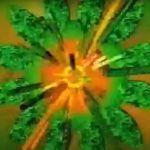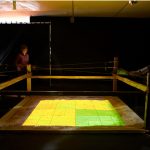“Psy-Vision” by Troy Innocent
Title:
Artist(s) and People Involved:
Filmmaker, Video Artist, or Animator(s):
- Troy Innocent
-
- Swinburne University of Technology
Symposium:
Venue(s):
Artist Statement:
“A fusion of iconic figuration and synthetic abstraction towards a language for the visual expression of electronic music.”
Inspired by the sounds and structures of techno music, the Psy-Vision project represents a set of prototypical language elements for the visual expression of this new sound. Elements of this language include textures, spaces, icons, movements, colors, and animated figures which are extruded into the abstract three-dimensional space of the computer. This video experiments with electronic communication and digital semiotics, exploring the increasingly significant relationships that humans have with virtual spaces and virtual images. These evolving relationships shape and reflect human identity. A central concept to this new way of seeing media-space is the creation of figures that are iconic in form, often remapping other cultures and meanings onto these forms. Consequently, the codes of our contemporary media-space have been sampled, reformed and mutated in Psy-Vision, deliberately detached from any narrative context. This allows the figures and forms to become “visual instruments” whose actions and movements are played in sequence like music. These sequences consequently create visual constructions that represent the sound and evoke mood and atmosphere. Dimensions of time and space are intrinsic elements in the structure into which the forms of Psy-Vision are placed. A key feature of the iconic forms that populate these digital realms is their capacity to mutate and reconstruct themselves in varying modes of representation. This fluctuation and mutation of meaning is a characteristic unique to electronic space, where information can be mapped in multiple ways depending on how its meaning is defined. The techno sound can be said to represent, among many other things, humans exploring the language of machines. The sounds are a manifestation of the ongoing development of relationships with machines and how we perceive their role in our lives. The music, which ranges from minimal abstract frequencies and rhythms to densely layered soundtracks and mutant karaoke, is spatial and experiential in nature and thus ideally suited to being mapped into virtual space. On top of the basic elements of this spatial language, different visual styles are superimposed giving each track in the Psy-Vision sequence it’s own identity and place. The intention is not to create a Virtual mirror of reality, but to create imaginative new spaces, spaces that provide a “natural” place for this music to reside. Each visual space becomes the home to a particular symbolic form, which is explored over the four to five minute duration of each phase. It is in these new evolving spaces that electronic communication systems will grow, offering more suitable ways to describe “identity” in places that do not really exist. Although these images and sounds draw upon a wide range of existing cultural meanings, their representation in virtual space is relatively new to us. Thus their deeper meanings will evolve as they are absorbed into our culture.
Additional Images:
- Innocent: Psy-Vision
- Innocent: Psy-Vision
Image 02 & 03: video still from YouTube



















